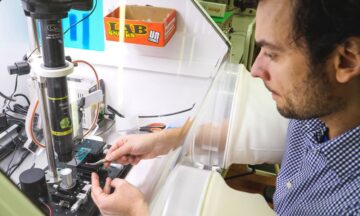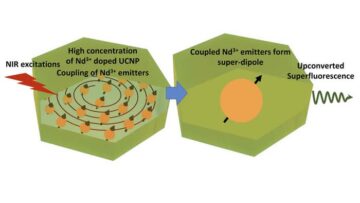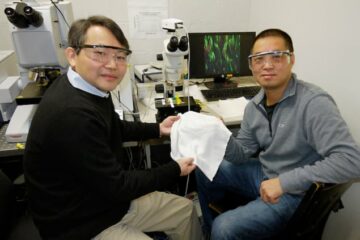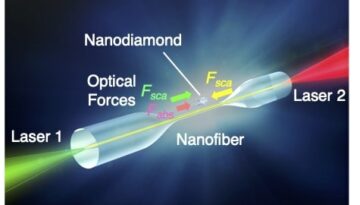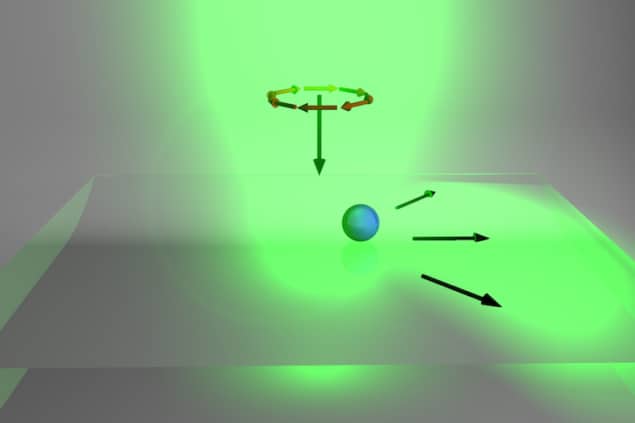
Being able to precisely locate individual nanoparticles in a device is no easy task but it is important for many research fields, including nanometrology, medicine and biophysics. A team of scientists in Germany has now taken an important step forward towards this goal with an all-optical technique that works thanks to an effect known as Kerker scattering. The technique can locate nano-objects with a spatial resolution of less than one angstrom, which is the size of an atom.
The Kerker effect is named after Milton Kerker who used light scattering to study aerosols and colloids. Kerker showed that when ordinary, plane-polarized, light scatters from a nanoparticle (that is much smaller than the wavelength of light), highly asymmetric patterns are produced. The effect occurs in particles that respond in a similar way to both magnetic and electric fields and comes about thanks to interactions of the electric and magnetic components of the light beam and the particle.
Transverse Kerker scattering
The new technique, developed by Peter Banzer of the Max Planck Institute for the Science of Light and colleagues relies on this effect but their experiment is slightly different. The researchers use a tightly focused, azimuthally polarized light beam instead of a plane-polarized one to excite a silicon sphere measuring 156 nm across coated with a 6-nm-thin layer of SiO2. The asymmetric scattering pattern produced perpendicular to this beam changes whenever the particle moves away from an original, central position. The effect, which is known as transverse Kerker scattering, can be observed using a CCD camera and easily measured, explains Banzer.
“While Kerker originally suggested pronounced anisotropic (forward and backward) light scattering by the simultaneous excitation of electric and magnetic dipoles in a particle using a planar, unstructured wave, we have now modified this approach by utilizing nanostructured light. In our scheme, we observe a strong directionality of the signal not along the propagation direction of the exciting light beam, but orthogonal (transverse) to it. In simple terms, we redirect light, if you will, by directional interference.”
Technique could help stabilize positioning systems in microscopes
“We expect our work to have an impact on a number of applications and research fields,” he tells Physics World. “By monitoring the location and motion of a nanoparticle with an accuracy and precision below the size of a single atom (less than one angstrom), we could stabilize positioning systems in microscopes and lithography probes. This could help increase the achievable resolution in these instruments.”
The researchers, reporting their work in Physical Review Letters doi.org/10.1103/PhysRevLett.121.193902, say they are now busy developing an extension of their transverse Kerker-based localization scheme that will allow for ultra-fast time-resolved position sensing as well as the high spatial resolution described in the present work. “Such a system could serve as a sensor with a feedback-loop to stabilize positioning stages in nanometrology, imaging and fabrication,” says Banzer.
- SEO Powered Content & PR Distribution. Get Amplified Today.
- PlatoData.Network Vertical Generative Ai. Empower Yourself. Access Here.
- PlatoAiStream. Web3 Intelligence. Knowledge Amplified. Access Here.
- PlatoESG. Automotive / EVs, Carbon, CleanTech, Energy, Environment, Solar, Waste Management. Access Here.
- PlatoHealth. Biotech and Clinical Trials Intelligence. Access Here.
- ChartPrime. Elevate your Trading Game with ChartPrime. Access Here.
- BlockOffsets. Modernizing Environmental Offset Ownership. Access Here.
- Source: https://physicsworld.com/a/kerker-scattering-locates-particles-with-sub-atomic-precision/
- :has
- :is
- :not
- a
- Able
- About
- accuracy
- across
- After
- allow
- along
- an
- and
- applications
- approach
- ARE
- AS
- atom
- away
- BE
- Beam
- below
- Biophysics
- both
- busy
- but
- by
- camera
- CAN
- CCD
- central
- Changes
- colleagues
- comes
- components
- could
- described
- developed
- developing
- device
- different
- direction
- easily
- easy
- effect
- Electric
- exciting
- expect
- experiment
- Explains
- extension
- Fields
- focused
- For
- Forward
- from
- Germany
- goal
- Have
- he
- help
- High
- highly
- HTML
- HTTPS
- if
- image
- Imaging
- Impact
- important
- in
- Including
- Increase
- individual
- information
- instead
- Institute
- instruments
- interactions
- issue
- IT
- jpg
- known
- layer
- less
- light
- Localization
- location
- many
- max-width
- measured
- measuring
- medicine
- Milton
- modified
- monitoring
- motion
- moves
- MPL
- much
- Named
- New
- no
- now
- number
- observe
- observed
- of
- on
- ONE
- ordinary
- original
- originally
- our
- particle
- Pattern
- patterns
- Physics
- Physics World
- plato
- Plato Data Intelligence
- PlatoData
- position
- positioning
- precisely
- Precision
- present
- Produced
- pronounced
- propagation
- redirect
- Reporting
- research
- researchers
- Resolution
- Respond
- review
- say
- says
- scheme
- Science
- scientists
- serve
- showed
- Signal
- Silicon
- similar
- Simple
- simultaneous
- single
- Size
- slightly different
- smaller
- Spatial
- stabilize
- stages
- Step
- strong
- Study
- system
- Systems
- taken
- Task
- team
- tells
- terms
- than
- thanks
- that
- The
- their
- These
- they
- this
- thumbnail
- tightly
- to
- towards
- true
- use
- used
- using
- Utilizing
- Wave
- Way..
- we
- WELL
- when
- whenever
- which
- WHO
- will
- with
- Work
- works
- world
- you
- zephyrnet


